Construction has begun on a cosmic ray observatory in the Utah desert that should be 10 times more sensitive than previous instruments. The observatory should be ready for tests by early 2007, and start full operations by summer 2007. The “Telescope Array” is made up of 564 table-shaped detectors, which will measure showers of subatomic particles that fall to Earth when cosmic rays interact with our atmosphere. It will help scientists uncover the source of ultrahigh-energy cosmic rays.
Continue reading “Construction Begins on Cosmic Ray Observatory”
First Mirror Cast for the Giant Magellan Telescope
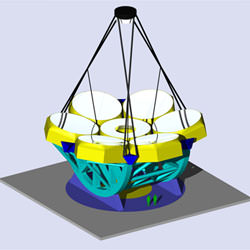
Computer illustration of the GMT’s 7 giant mirrors. Image credit: GMT. Click to enlarge.
The University of Arizona Steward Observatory Mirror Lab’s casting of the first mirror for the Giant Magellan Telescope (GMT) “appears to be essentially perfect,” UA Steward Observatory director Peter Strittmatter said after astronomers got their first look at the glass last Friday.
“We’re very happy to see this one come out looking so gorgeous,” Mirror Lab Technical Director J. Roger Angel said. “We’ll see more once the mold is removed, but so far, looking through the front surface, it looks great.”
The mirror is the first of seven 8.4-meter (27-foot) mirrors that the Mirror Lab is making for the Giant Magellan Telescope. The GMT is the world’s first extremely large ground-based telescope to start construction.
The colossal telescope will feature six giant off-axis mirrors around a seventh on-axis mirror. This arrangement will give it a 22-meter (72-foot) aperture, or 4.5 times the collecting area of any current optical telescope. It will have the resolving power of a 24.5-meter (80-foot) diameter telescope, or 10 times the resolution of the Hubble Space Telescope. The GMT is slated for completion in 2016 at a site in northern Chile.
Randy Lutz and the Mirror Lab casting team knew they had a superb first GMT mirror blank when they removed the casting furnace lid Oct. 21. But they aren’t standing around to admire their handiwork. They’re racing to remove furnace walls and ready the mirror blank for moving off the furnace hearth.
“We’re very eager to get on to the critical part of why we made this mirror — to the polishing and the testing, which are really the new ground-breaking steps in making this mirror because its shape is so different,” Angel said. “We’re moving fast because we want to get on with casting the next mirror, a 3.7-meter mirror that will be needed to measure the shape of the GMT primary mirrors.”
Mirror Lab workers are about to disassemble their facility’s 7.5-story test tower (that’s 27 meters, or 88 feet) and construct a higher tower that will hold the 3.7-meter (12-foot) mirror for measuring the off-axis GMT mirrors. The test mirror is crucial for making measurements needed for shaping all the primary mirrors so they gather and focus light as a single gargantuan primary mirror.
Meanwhile, Steward Observatory Mirror Lab scientists Buddy Martin and Jim Burge are already polishing a one-fifth scale prototype of the GMT primary. Polishing the full size off-axis mirror will be a huge step forward in the GMT project, Angel said.
For the casting last July, Mirror Lab workers used 40,000 pounds of Ohara E-6 borosilicate glass. The furnace hit peak temperature, 2,150 degrees Fahrenheit (1,178 Celsius) on July 23. As the furnace rotated at 5 revolutions per minute, glass melted around the 1,681 hexagonal cores in the mold. This created a ‘honeycomb’ mirror blank with a faceplate of the desired curvature. The honeycomb mirror weighs only a fifth as much as would a solid mirror of the same size.
The first GMT primary is the third 8.4-meter mirror cast at the Steward Observatory Mirror Lab. The GMT builds on the very successful 6.5-meter (21-foot) Magellan telescopes which many of the same GMT partners operate in Chile.
Eight institutions are partners in the GMT. They are the Carnegie Observatories, Harvard University, Smithsonian Astrophysical Observatory, University of Arizona, University of Michigan, Massachusetts Institute of Technology, University of Texas at Austin, and Texas A & M University.
The two other 8.4-meter mirrors cast at the Mirror Lab are at the Large Binocular Telescope (LBT) on Mount Graham, Ariz. U.S., Italian and German partners in the LBT released ‘first light’ images obtained with the first of the LBT’s primary mirrors yesterday (Oct. 26). The LBT, the forerunner of the GMT, will be the world’s most powerful single telescope when its two primary mirrors, mounted side-by-side, become operational in 2006.
Original Source: UA News Release
Binocular Telescope Sees First Light
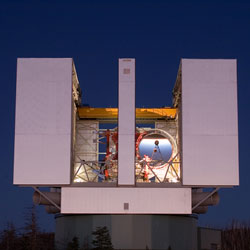
Large Binocular Telescope, positioned on the 3190-meter high Mount Graham in Arizona. Image credit: Max Planck Institut for Astronomy. Click to enlarge.
The two mirrors of the Large Binocular Telescope (LBT) have produced their first scientific images of space. The event, known among astronomers as”first light’, is a major milestone in the launch of the largest and most modern single telescope in the world. The LBT will be able to see more clearly and more deeply into the universe than any of its predecessors. Led by the Max Planck Institute for Astronomy, five German institutes participated, garnering a total of 25 percent of the observation time. Among them were the Max Planck Institutes for Astronomy in Heidelberg, Extraterrestrial Physics in Garching, and for Radio Astronomy in Bonn, as well as the Landessternwarte (state observatory), part of the Centre for Astronomy in Heidelberg.
The Large Binocular Telescope, positioned on the 3190-meter high Mount Graham in Arizona, is one of the most prominent scientific-technical projects in modern astronomical research. Its name describes it well: it has two giant mirrors, each of them with a diameter of 8.4 metres. They are mounted onto the same surface, and focussed, like field glasses, at the same time on distant space objects. The surface of the mirrors is polished with extreme precision, down to one 20 millionth of a millimetre. If an LBT mirror were enlarged to the size of Lake Constance in the Alps – just slightly larger than the area of New York City – the”waves’ on the lake would be only one-fifth of a millimetre high. In spite of their size, each of the two mirrors”only’ weighs 16 tonnes. A classical telescope, on the other hand, at the dimensions of the LBT, would have thick mirrors weighing some 100 tonnes. It would be impossible to construct such a large classical telescope.
By combining the optical paths of the two individual mirrors, the LBT collects as much light as a telescope whose mirrors have a diameter of 11.8 meters. This is a factor of 24 larger than the 2.4 metre mirrors of the Hubble Space Telescope. Even more importantly, the LBT has the resolution of a 22.8 metre telescope, because it uses the most modern adaptive optics, superimposing pictures with an interferometric procedure. The astronomers are thus able to compensate for the blurring caused by air turbulence, and see into the universe much more clearly than Hubble.
Professor Thomas Henning, Managing Director of the Max Planck Institute for Astronomy, and Dr Tom Herbst, a scientist in the German consortium, both agree that”The LBT will open completely new possibilities in researching planets outside the solar system and the investigation of the furthest – and thus youngest – galaxies.’
Professor Gerd Weigelt, Director of the Max Planck Institute for Radio Astronomy in Bonn, says that”The first LBT pictures give us an idea of what kind of fascinating picture quality we can expect.’ Although in the beginning, the pictures are”only’ being collected with one of the two main mirrors, they are already showing an impressive view of the distant Milky Way. One of them is of an object in the constellation Andromeda called NGC891, a spiral galaxy 24 million light years away, which, from the earth’s perspective, we can only see from the side. According to Professor Reinhard Genzel, the Managing Director of the Max Planck Institute for Extraterrestrial Physics in Garching,”The object is of particular interest to astronomers, because it also sends out a lot of x-rays’.”This radiation was created by a large number of massive stars whose lives come to an end with spectacular supernova explosions – a kind of cosmic fireworks.’
.
The pictures were created using a high-tech Large Binocular Camera (LBC), developed by Italian partners in the project. The camera and telescope work together like a giant digital camera. Thanks to the particularly large field of view, very efficient observations are possible – for example, the creation and development of distant galaxies with weak light.
But the LBC camera is just the first of a whole line of high-tech instruments with which the LBT will be equipped in the future.”A telescope without instruments is like an eye without a retina,’ says Professor Hans-Walter Rix, Director of the Max Planck Institute for Astronomy. The scientist, a member of the LBT project for many years, adds that”a telescope like the LBT only becomes an powerful observatory in combination with powerful measuring instruments that are equipped with sensitive detectors.’
German partners especially participated in the development and construction of the instruments, and thus were able to secure for themselves 25 percent of observation time. Scientists, technicians, and electricians from the LBT-Beteilungsgesellschaft (LBT participation group) built the control software LUCIFER 1 and 2, which makes it possible to gather infrared pictures and spectra of heavenly objects. Dr Immo Appenzeller of the Landessternwarte Heidelberg calls it”important for detailed investigations of a great number of galaxies at different stages of development.’
Professors Matthias Steinmetz and Klaus Strassmeier, the Directors of the Astrophysics Institute in Potsdam, explain that”the PEPSI instrument is a particularly high resolution version of what is called an Echelle spectrograph. With it, we can conduct particularly effective investigations of the structure and dynamics of the surface of stars.’ At the Institute, the Acquisition, Guiding, and Wavefront sensing units are being built, which are responsible for the exact tracking of the telescope, as well as for mirror adjustments.
The LINC-NIRVANA instrument has also been built to ensure that the LBT and its instruments stay at full effectiveness. The LINC-NIRVANA, built in co-operation with Italian partners, is the heart of the LBT. It brings the light from two main mirrors to a single focal plane and corrects for picture interference due to the earth’s atmosphere. The highest demands are being placed on the optical, electronic, and mechanical components, because when being used in the infrared spectrum, parts of the LINC-NIRVANA must be cooled to minus 196 degrees in order not to be”blinded’ by heat radiation around it. In this field of”cryotechnology’, scientists and technicians from the Max Planck Institute for Astronomy have shown great expertise.
Because of the impressive first pictures, the astronomers now know that more than 20 years of planning, development, and construction have paid off, and that the 120 million dollar project is on the way to offering new insights into the cosmos. This was indeed the goal of the people who initiated German participation in the project, among them Professor Günther Hasinger (Max Planck Institute for Extraterrestrial Physics, formerly of the Astrophysical Institute in Potsdam) and Professor Steven Beckwith (formerly of the Max Planck Institute for Astronomy). But it is not only the scientists who have participated in the project for such a long time that will profit from the LBT’s observations. Now, students and future scientists at all the partner institutes will have the chance to analyse LBT data and initiate new observation projects.
Original Source: Max Planck Institute News Release
Keck Can Turn Down Starlight to See Planetary Disks
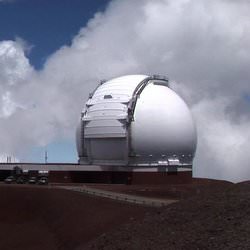
The massive Keck telescope on Hawaii’s Mauna Kea. Image credit: NASA/JPL. Click to enlarge.
Are we alone in the universe? Are there planets like Earth around other ?suns? that might harbor life? Thanks to a recent technology breakthrough on a key NASA planet-finding project, the dream of answering those questions is no longer light-years away.
On a crystal clear, star-filled night at Hawaii?s Keck Observatory in Mauna Kea, NASA engineers successfully suppressed the blinding light of three stars, including the well-known Vega, by 100 times. This breakthrough will enable scientists to detect the dim dust disks around stars, where planets might be forming. Normally the disks are obscured by the glare of the starlight.
Engineers accomplished this challenging feat with the Keck Interferometer, which links the observatory?s two 10-meter (33-feet) telescopes. By combining light from the telescopes, the Keck Interferometer has a resolving power equivalent to a football-field sized telescope. The ?technological touchdown? of blocking starlight was achieved by adding an instrument called a ?nuller.?
This setup may eventually help scientists select targets for NASA?s envisioned Terrestrial Planet Finder missions. The success of those potential future missions, one observing in visible light and one in infrared, depends on being able to find Earth-like planets in the dust rings around stars.
?We have proven that the Keck Interferometer can block light from nearby stars, which will allow us to survey the amount of dust around them,? said Dr. James Fanson, project manager for the Keck Interferometer at NASA’s Jet Propulsion Laboratory. That survey will begin in late 2006 after the team refines the nuller?s sensitivity level.
Combined information from all of NASA?s planet-hunting missions will provide a complete picture of possible Earth-like planets: how big they are, whether they are warm enough for life, and if their atmospheres and surfaces show chemical signatures of current life.
?People have been talking about whether there are other earths out there for 2,500 years. Only now are we developing the technology to go find out,? said Michael Devirian, manager of NASA?s Navigator Program at JPL, which is investigating potential planet-exploring missions.
So far, scientists around the world have found 150 planets orbiting other stars. Most are giants, like Jupiter; none is as small as Earth. Scientists believe the best odds of finding life outside our solar system are on Earth-sized planets, particularly those with the right temperature, density and chemistry.
More information on NASA?s planet-finding missions, including the Keck Interferometer and Terrestrial Planet Finder is at http://planetquest.jpl.nasa.gov.
JPL manages the Keck Interferometer and the Terrestrial Planet Finder missions for NASA?s Science Mission Directorate, Washington. JPL is a division of the California Institute of Technology in Pasadena. The W.M. Keck Observatory is funded by California Institute of Technology, the University of California and NASA, and is managed by the California Association for Research in Astronomy, Kamuela, Hawaii.
Original Source: NASA/JPL News Release
Giant South African Telescope Online
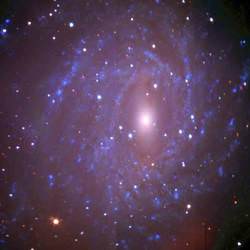
NGC 6744 taken by SALT. Image credit: SALT Click to enlarge
Five years after breaking ground on a South African mountaintop near the edge of the Kalahari desert, astronomers today (Sept. 1, 2005) released the first images captured by the Southern African Large Telescope (SALT), now the equal of the world’s largest optical telescope and a prized window to the night skies of the southern hemisphere.
With a 10- by 11-meter hexagonal segmented mirror and state-of-the-art scientific instrumentation, the new telescope was constructed by an international consortium of universities and government agencies. Partners include the National Research Foundation of South Africa, UW-Madison’s College of Letters and Science, Poland’s Nicolas Copernicus Astronomical Centre and Rutgers University, among others.
The new $18 million observatory will provide unprecedented access to the astronomically rich skies of the southern hemisphere. Objects such as the Large and Small Magellanic Clouds, the galaxies nearest to our own Milky Way, will come into sharp view through the concerted focus of the 91 hexagonal mirror segments that comprise the SALT Telescope’s primary mirror array.
“We’re now players in the world of large telescopes,” says Eric Wilcots, a UW-Madison professor of astronomy. “We’re in an age in which answering the big, fundamental questions requires access to large telescopes in good, dark skies. SALT is just such a telescope.”
Access to the southern sky, says Wilcots, promises a bounty of observing: “The southern Milky Way is more spectacular and provides a richer treasure trove of objects than the northern Milky Way.”
Moreover, studies of thousands of individual stars in the Magellanic Clouds are planned to trace the history of those nearby galaxies. The results of those studies, Wilcots explains, can be extrapolated to galaxies in general, providing a more refined life history of objects like our own Milky Way.
Other southern sky objects of interest, according to Kenneth Nordsieck, a UW-Madison astronomer now in South Africa to help with the SALT Telescope’s commissioning, include Eta Carina, a nearby massive star that has been racked by a series of enigmatic and spectacular explosions over the past century; Omega Centauri, a globular cluster of stars in the Milky Way that some astronomers believe may be the fossil remains of another galaxy consumed long ago by the Milky Way; and Centaurus A, a nearby galaxy that recently experienced an explosion at its core.
A critical advantage for the SALT Telescope, according to astronomers, is its location in one of the darkest regions of the world. With no nearby cities or towns, the observatory will be little affected by the light pollution that seriously hampers many observatories in the Northern Hemisphere.
Together with Rutgers University, another member of the SALT consortium, Wisconsin astronomers and engineers have constructed and are now integrating into the observatory the primary scientific instrument for the telescope, a device known as the Prime Focus Imaging Spectrograph. When in place six stories above the primary mirror array, the $5 million device will give the SALT Telescope specialized capabilities to capture and analyze starlight in unprecedented ways.
Spectrometers are designed to parse light into its constituent wavelengths. The spectra they obtain are revealing, providing astronomers with far more information than simple images. They can help show the chemical makeup of objects, depict motion, and some wavelengths of light enable astronomers to see through the obscuring clouds of dust and gas that permeate space.
One specialized capability of the Prime Focus Imaging Spectrograph, according to Nordsieck, is the ability to make observations in the near ultraviolet, the same kind of light that causes sunburn. “This is one of the few big instruments that will be good in the ultraviolet,” says Nordsieck.
The images released today through the South African Astronomical Observatory, the SALT Observatory’s parent organization, were taken with a digital camera known as SALTICAM. They include stunning pictures of the Lagoon Nebula, a luminous stellar nursery; the globular star cluster 47 Tucanae; and NGC6744, a barred spiral galaxy that astronomers consider almost a twin of our own Milky Way.
“The declaration of first light signifies that SALT has arrived on the astronomical scene,” according to a statement issues by the South African Astronomical Observatory. Although a months-long period of commissioning and shakedown remains, “SALT is now in a very real sense an operational telescope.”
A critical upcoming milestone will be the integration of the Wisconsin-built Prime Focus Imaging Spectrograph, envisioned as the workhorse instrument for the SALT Telescope. Capable of capturing high-resolution pictures, movies and the telltale spectra of objects such as stars, galaxies and comets, the device will be perched high above the light gathering primary mirror array at the heart of the new telescope.
Installation is expected in mid-September. “It is progressing in fits and starts, about the way one would expect with something of this complexity,” says Nordsieck. “In the meantime, the telescope team has worked out a lot of kinks so there should be a relatively smooth commissioning.”
The development of the SALT Observatory, says Wilcots, is “a beacon for Southern African science. It is meant to inspire a new generation of African scientists, which will be the lasting value of SALT to Southern Africa.”
For UW-Madison, the telescope project represents a bridge from Madison to South Africa. “Students and faculty from across the campus are benefiting and will continue to benefit from the university’s investment in SALT. We now have a student exchange program with the University of Cape Town and we will be initiating an exchange with the University of the Western Cape in November,” says Wilcots.
He emphasizes that the South Africans are making a statement with their investment in the giant telescope. “It is meant to showcase the capability of Southern African scientists and engineers – and it has done that,” Wilcots says. “Keep in mind that there are only a handful, perhaps as few as three, black South Africans with Ph.Ds in astronomy. While we have problems with an underrepresented minority in science, South Africa has an under-represented majority.”
Original Source: UW-Madison News Release
Space Telescope Could Unfold in Space
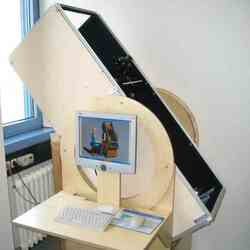
Collimation testbed of the Dobson telescope. Image credit: Tom Segert. Click to enlarge
A novel suitcase-sized telescope could revolutionise the way we see the Earth and other planets. ESA has supported the work of a group of students in developing the Dobson Space Telescope, being tested this month aboard ESA’s parabolic flight campaign aircraft.
This experimental prototype launches in a compact configuration and then unfolds to provide a cost-effective space telescope. It could lead to fleets of low-cost telescopes, bigger than the Hubble Space Telescope.
Large payloads are difficult to put into space because they are usually heavy and expensive to launch. Now a revolutionary design of unfolding telescope, inspired by telescopes used by amateur astronomers, is ready to enter a phase of detailed testing. If successful, it could dramatically reduce the cost of placing telescopes in space.
The telescope is a project of the Department of Astronautics at the Technische Universit?t Berlin, Germany. “We called our project the Dobson Space Telescope because we borrowed the idea from the Dobsonian telescopes used by amateur astronomers,” says project manager Tom Segert, who has recently completed his degree at TU Berlin. Dobsonian telescopes are often comprised of two mirrors, held the correct distance apart by long poles. They can be dismantled and transported by car to a good observing site, where there are reassembled with nothing more complicated than a screwdriver.
In space, however, a screwdriver is useless unless you have an astronaut to turn it and so Segert plans to use a motor to unfold his telescope. Working on a shoestring budget, his first prototype used inflatable bicycle tyres to push the mirrors into position. When this proved incapable of aligning the telescope optics, Segert turned to metal truss rods and micromechanics to unfold everything into its correct place.
Using a grant from ESA’s General Studies Programme, Segert and other TU Berlin students have written a full technical report and built a prototype for testing in this month aboard ESA’s parabolic flight campaign aircraft. As the aircraft flies special manoeuvres, the prototype will experience periods of free-fall that mimic the conditions in space. During this time, Segert will test the telescope?s ability to unfold. Eventually, Segert hopes for a demonstration mission in space.
Currently, space-based observations account for just one tenth of the commercial Earth observation market. The rest is supplied by aeroplane reconnaissance, which is much cheaper. Space observations cost 20 Euros per kilometre whereas aeroplane data is twenty times cheaper. Segert believes that cost-effective Earth observation microsatellites, based on his telescope design, will allow all users access to space images.
There is also nothing to stop a Dobson Space Telescope from turning its attention from Earth to the wider cosmos. In fact, Segert imagines the first missions could ‘timeshare’ between Earth and astronomical observation. “When the telescope flies into the shadow of the Earth and so can’t take pictures of the ground, we could turn it around and observe astronomical targets,” he says.
Future versions could be sent to other planets. As the telescope is so lightweight, it could be mounted on a Mars Express-sized spacecraft and used to take pictures showing details as small as 30 cm across on the Martian surface.
Although the prototype contains a respectable 50 cm-diameter mirror, Segert believes that it can scaled up in the future to achieve space telescopes bigger than the Hubble Space Telescope but still at a fraction of the cost. “If we did that,” says Segert, “the astronomers would be in heaven.”
Original Source: ESA Portal
APEX Telescope Sees First Light
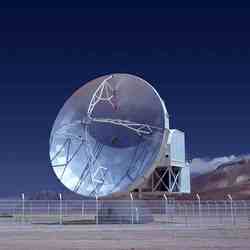
The APEX Telescope at Chajnantor. Image credit: ESO. Click to enlarge
The Atacama Pathfinder Experiment (APEX) project has just passed another major milestone by successfully commissioning its new technology 12-m telescope, located on the 5100m high Chajnantor plateau in the Atacama Desert (Chile). The APEX telescope, designed to work at sub-millimetre wavelengths, in the 0.2 to 1.5 mm range, has just performed its first scientific observations. This new front-line facility will provide access to the “Cold Universe” with unprecedented sensitivity and image quality.
Karl Menten, Director of the group for Millimeter and Sub-Millimeter Astronomy at the Max-Planck-Institute for Radio Astronomy (MPIfR) and Principal Investigator of the APEX project is excited: ” Among the first observations, we have obtained wonderful spectra, which took only minutes to take but offer a fascinating view of the highly complex organic chemistry in star-forming regions. In addition, we have also obtained exquisite images from the Magellanic Clouds and observed molecules in the active nuclei of several external galaxies. Traditionally, telescopes turn to weak extragalactic sources only after they are well in operation. With APEX, we could pick them amongst our first targets!”
Because sub-millimetre radiation from space is heavily absorbed by water vapour in the Earth’s atmosphere, APEX is located at an altitude of 5100 metres in the high Chilean Atacama desert on the Chajnantor plains, 50 km east of San Pedro de Atacama in northern Chile. The Atacama desert is one of the driest places on Earth, thus providing unsurpassed observing opportunities – at the costs of the demanding logistics required to operate a frontier science observatory at this remote place.
Along with the Japanese 10-m ASTE telescope, which is operating at a neighbouring, lower altitude location, APEX is the first and largest sub-millimetre facility under southern skies. With its precise antenna and large collecting area, it will provide, at this exceptional location, unprecedented access to a whole new domain in astronomical observations. Indeed, millimetre and sub-millimetre astronomy opens exciting new possibilities in the study of the first galaxies to have formed in the Universe and of the formation processes of stars and planets. APEX will, among other things, allow astronomers to study the chemistry and physical conditions of molecular clouds, that is, dense regions of gas and dust in which new stars are forming.
APEX follows in the footsteps of the 15m Swedish-ESO Submillimetre Telescope (SEST) which was operated at ESO La Silla from 1987 until 2003 in a collaboration between ESO and the Onsala Space Observatory. SEST operated in the wavelength range from 0.8 to 3 mm. Says Catherine Cesarsky, ESO’s Director General: “SEST was for a long time the only instrument of its kind in the southern hemisphere. With it, ESO and our collaborators have gained valuable operational experience with regard to ground-based observations in the non-optical spectral domain. With APEX, we offer the ESO community a most exciting new facility that will pave the way for ALMA.”
As its name implies, APEX is the pathfinder to the ALMA project. It is indeed a modified ALMA prototype antenna and is located at the future site of the ALMA observatory. ALMA is planned to consist of a giant array of 12-m antennas separated by baselines of up to 14 km and is expected to start operation by the end of the decade. It will bring to sub-millimetre astronomy the aperture synthesis techniques of radio astronomy, enabling precision imaging to be done on sub-arcsecond angular scales, and will so nicely complement the ESO VLT/VLTI observatory.
In order to operate at the shorter sub-millimetre wavelengths, APEX presents a surface of exceedingly high quality: after a series of high precision adjustments, the APEX project team was able to adjust the surface of the mirror with remarkable precision: over the 12m diameter of the antenna, the deviation from the perfect parabola is now less than 17 thousandths of a millimetre. This is smaller than one fifth of the average thickness of a human hair!
“From the engineering point of view, APEX is already a big success and its performance surpasses our expectations”, says APEX Project Manager Rolf G?sten. “This could only be achieved thanks to the highly committed teams from the constructor, from the MPIfR and from the APEX project whose endless hours of work, often at high altitudes, made this project become reality.”
In parallel to the construction and commissioning of the APEX telescope, a demanding cutting-edge technology program has been launched to provide the best possible detectors for this outstanding facility. For its first observations, APEX was equipped with state-of-the-art sub-millimetre spectrometers developed by MPIfR’s Division for Sub-Millimetre Technology and, more recently, with the first facility receiver built at Chalmers University (OSO).
APEX is a collaboration between the Max-Planck-Institute for Radio Astronomy (MPIfR), Onsala Space Observatory (OSO), and the European Organisation for Astronomical Research in the Southern Hemisphere (ESO). The telescope was designed and constructed by VERTEX Antennentechnik GmbH (Germany), under contract by MPIfR, and is based on a prototype antenna constructed for the ALMA project. Operation of APEX in Chajnantor is entrusted to ESO.
Background information on sub-millimetre astronomy and on the first APEX results can be found as PDF files on the APEX Fact Sheets page.
Original Source: ESO News Release
Extremely Large Telescope Takes the Next Step
Astronomers from across Europe today (July 7th) took a step closer to making their plans for a giant telescope a reality when they unveiled the scientific case for an Extremely Large Telescope (ELT) – a monster telescope with a light capturing mirror of between 50 and 100 metres, dwarfing all previous optical telescope facilities. The announcement was made at a meeting in Dwingeloo, the Netherlands and initiates the design phase of the project. Astronomers plan to use the ELT to search for planets like the Earth in other star systems and to find out when the first stars in the Universe began to shine.
The first step when selecting the specifications and design options for a new telescope is for astronomers to establish the science that could be achieved with the facility. The science case launched today will be used in a Design Study funded by the European Union’s Framework 6 Programme and a Europe-wide consortium of partners, including industry, aimed at evaluating critical technologies needed to build a giant telescope, and led by the European Southern Observatory (ESO). The UK part of this ?30M programme is led by the UK Astronomy Technology Centre (UK ATC) and partly funded by the Particle Physics and Astronomy Research Council (PPARC).
Roberto Gilmozzi, ESO’s coordinator of the ELT Design Study said, “The ELT Design Study initiative, a 31 MEuro activity partially funded by the FP6, shows the willingness of Europe to pursue a common path towards the eventual construction of an ELT. It is a design independent study of enabling technologies that brings together European institutes and industry to define a palette of ELT “building blocks” that indicate the way in which the telescope design should evolve to take advantage of the directions industry believes are most appropriate and cost effective.”
Bigger is better
The power of optical telescopes is limited by the size of the mirror that is used to collect light, which in turn determines how well they can distinguish between faint objects – the bigger the mirror, the fainter the object that the telescope will be able to see. For example, a 100m telescope with perfect compensation for atmospheric disturbances would be able to separate two points on the moon two metres apart, compared with 95m apart for the Hubble Space Telescope.
The quest for bigger mirrors has pushed current technologies to their limits. Some of the most advanced 8-10 metre telescopes now rely on mirrors constructed from smaller mirror segments, controlled by computers to act as a single large surface. These new techniques offer astronomers the opportunity for an unprecedented step-up in size. A 100m telescope would use a greater area of precision mirrors than has been made for all the previous telescopes ever built!
Dr Isobel Hook from the University of Oxford has led the working group producing the science case. She says “An Extremely Large Telescope is a very exciting prospect for astronomers. Something with a 50 or even 100 metre mirror could completely change our understanding of the Universe and answer truly fundamental questions such as ‘Is the Earth unique?’ and ‘How did the first stars and galaxies form?’. We will have much more information than ever before – it will be a bit like being there when the first telescopes were pointed at the sky.”
The next step
The European ELT Design Study is a five year project to explore the challenges of building an ELT, with most of the work being done in the initial three years. Every aspect of the ELT project will be examined, from site selection to instrumentation. It is due to report in 2008 at which time it will present a range of options to funding agencies.
The design study will provide the crucial technical information needed to make tough decisions at the next stage. This will involve balancing the size and design of the telescope against cost and time of first operation. Building work is likely to start in the next decade and the telescope could start scientific operations from 2015!
Professor Gerry Gilmore of the Institute of Astronomy Cambridge and Chair of the EU OPTICON network, said “Development of the ELT science case has involved over 100 European astronomers, and 3 years of work. All this happened because the astronomers want it: an ELT is overwhelmingly the scientifically favoured next major astronomy development, with widespread and strong community support. Turning this bottom-up support into a science case and a design study proposal needed some resources, and a trans-national support structure, both naturally available and provided by the EC-funded OPTICON infrastructure network. This proves that European astronomers are becoming a single community, and as such are now international leaders in astronomy.”
PPARC, the UK funding agency for astronomy, has earmarked ?2million for research and development of an ELT for the period to April 2008. ?500,000 of this is to support the design study concentrating on UK strengths in instrumentation and adaptive optics led by the UK ATC, in partnership with Durham and Oxford Universities. The remainder of the programme is under evaluation, but will concentrate on key technologies such as lightweight and adaptive mirrors to enable the science goals to be met at an affordable cost.
Colin Cunningham, Director of Technology Development at the UK ATC says “A telescope of 50 to 100m in diameter will have outstanding sensitivity and resolution -but to reach this performance at an affordable cost requires us to address many engineering and technology challenges. The UK will be at the heart of these efforts through its part in the EU-supported ELT Design Study and our UK R&D programme which will bring together academic and industrial partners in preparation for the design and construction phase of this exciting project.”
Original Source: PPARC News Release
Podcast: Having a BLAST in the Arctic
If you’re an astronomer and you want to escape the Earth’s hazy atmosphere, you need a space telescope… right? Not necessarily, sometimes all you need is a balloon, and some clear arctic skies. An international team of researchers traveled to Sweden and deployed a 33-storey tall balloon carrying the BLAST telescope, designed to study the birth of stars and planets. Gaelen Marsden is a member of the team, and researcher at the University of British Columbia in Vancouver, Canada.
Continue reading “Podcast: Having a BLAST in the Arctic”
Making the Mirror for the World’s Largest Telescope
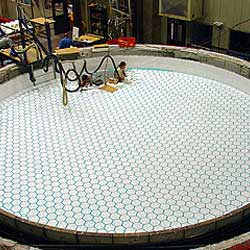
Workers completing the mold of the 8.4 metre mirror for the Giant Magellan Telescope mirror. Image credit: Lori Stiles/UA. Click to enlarge.
The University of Arizona’s Steward Observatory Mirror Lab is pre-firing its huge spinning furnace and inspecting tons of glass for casting a first 8.4-meter (27-foot) diameter mirror for the Giant Magellan Telescope (GMT). The casting is scheduled for Saturday, July 23.
With this milestone step, the GMT becomes the first extremely large ground-based telescope to start construction.
The completed GMT telescope primary mirror will consist of six 8.4-meter off-axis mirrors surrounding a seventh, on-axis central mirror. (An off-axis mirror focuses light at an angle away from its axis, unlike a symmetrical mirror that focuses light along its axis.) This arrangement will give the GMT four-and-one-half times the collecting area of any current optical telescope and the resolving power of a 25.6-meter (84-foot) diameter telescope, or 10 times the resolution of the Hubble Space Telescope.
‘Spin-casting’ single-piece telescope mirrors that are giant, stiff yet lightweight is an ingenious, awesome process that was conceived and developed by University of Arizona Regents’ Professor of astronomy J. Roger P. Angel. Casting giant monolithic mirrors is accomplished at only one place in the world — the Steward Observatory Mirror Laboratory.
The casting team, headed by Randy Lutz, installed about 50 cores a day for a total 1,681 cores during seven weeks in April – May. The team bolted each core at precisely measured angles to hearth tile and adjoining cores in this operation. The crew daubed all the glued junctures with blue “smurf” – a concoction the color of the blue smurf cartoon characters — to prevent glass from sticking to the mold.
At this point, the mold holds 17,000 pounds of hearth tiles, 16,000 pounds in fiber tub walls, and 15,000 pounds of cores and pins. The casting team has now cleaned and inspected the completed mold, lowered the furnace cover into place, and begun pre-firing on June 16.
Team members actively ‘pilot’ the furnace by computer as temperatures ramp up during the first 8 days of the heating process, then shut power off to complete the two-week pre-firing. Pre-firing centers core glue joints, burns out any impurities and stresses the mold. The casting team will inspect the mold for any needed repairs after pre-firing.
Some of the most visually stunning steps in casting are glass inspection and loading. The team began inspecting 90 shipping crates of glass on June 24. Glass loading is scheduled for the second week of July, said Steve Miller, Mirror Lab manager.
The 40,000 pounds of borosilicate glass that will make the 27-foot diameter (8.4 meter) GMT mirror comes from Ohara Glassworks in Japan. Ohara made the glass from sand that comes from the gulf coast of Florida.
The Mirror Lab will start heating the furnace July 18. It takes six days for the glass to reach peak temperature at 2,150 degrees Fahrenheit (1178 Celsius). At this temperature, the glass begins to flow like honey at room temperature. The thick liquid glass flows between the hexagonal cores in the mold to create a “honeycomb” structure. The final honeycomb mirror blank will weigh about a fifth as much as a solid glass mirror of its size.
The bearings on the rotating furnace will turn a 100-ton load during spincasting. The furnace can be supplied with up to 1.1 Megawatts of electricity during casting — enough to power an average 750 to 1,100 Tucson households, depending on the time of year.
The oven’s rotation rate determines the depth of the curve spun into the shape of the mirror, or the mirror’s focal length. The GMT mirror will spin 5 times a minute, slower than the two 8.4-meter mirrors the Lab made for the Large Binocular Telescope (LBT), because the off-axis GMT mirror is to be a shallower, longer focal-length mirror than the symmetric LBT primaries.
“This is a new epoch for astronomy,” Richard Meserve, president of the Carnegie Institution, said. “The fabrication of the off-axis mirror is a path-breaking event that will advance scientific discovery. Everyone in the eight-member GMT consortium is excited that we’re in production.”
The Giant Magellan Telescope consortium currently includes the Carnegie Observatories, Harvard University, Smithsonian Astrophysical Observatory, University of Arizona, University of Michigan, Massachusetts Institute of Technology, University of Texas at Austin, and Texas A & M University.
“The fact that we are already in production is directly related to the successful technology developed for the twin 6.5-meter (21-foot) Magellan telescopes at Carnegie’s Las Campanas Observatory in Chile,” said Matt Johns, assistant director of the Carnegie Observatories and GMT project manager. “The Magellan telescopes have proved to be the best natural imaging telescopes on the ground.”
Mirror cooling is a carefully controlled process that will take 11 to 12 weeks. After the mirror is completely cooled, the lab will wash the ceramic cores out of the mirror’s glass honeycomb cells. Then the mirror will be ground and polished to an accuracy of plus-or-minus 15 to 20 nanometers (a nanometer is a billionth of a meter). The mirror will be coated with a layer of reflective aluminum only 100 nanometers thick at the observatory site.
The GMT is slated for completion in 2016 at a site in northern Chile. With its powerful resolution and enormous collecting area, it will be able to probe the most important questions in astronomy, including the birth of stars and planetary systems in our Milky Way, the mysteries of black holes, and the genesis of galaxies.
Detailed information about the GMT design and science goals is online at http://www.gmto.org/
Original Source: UA News Release
